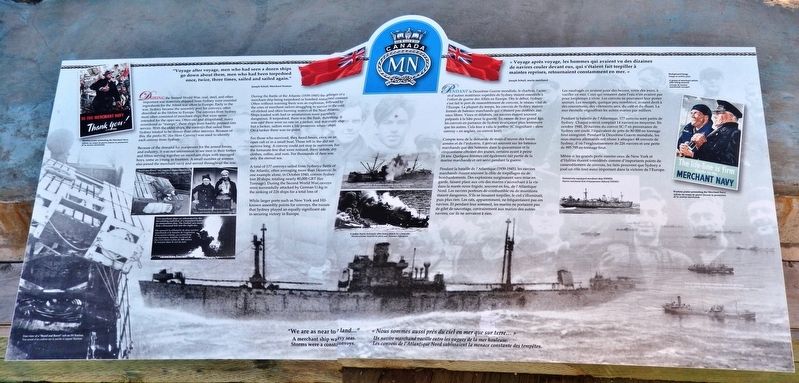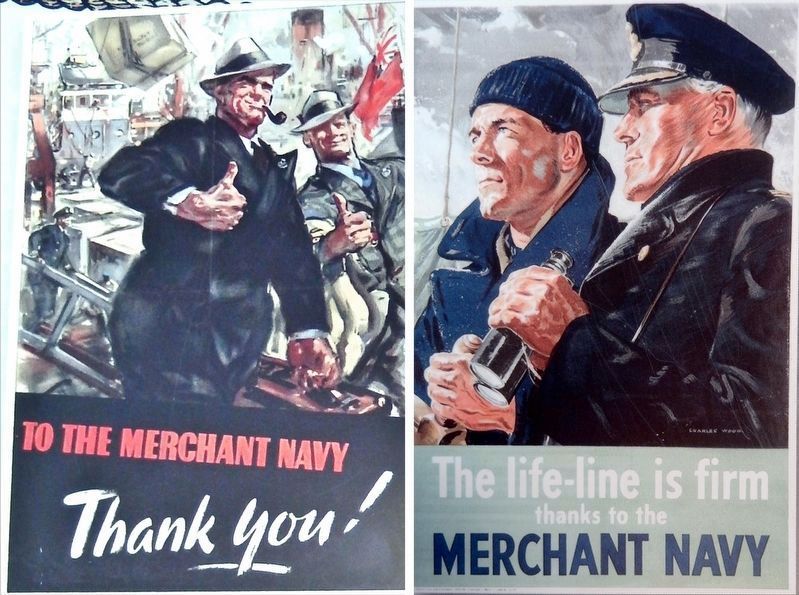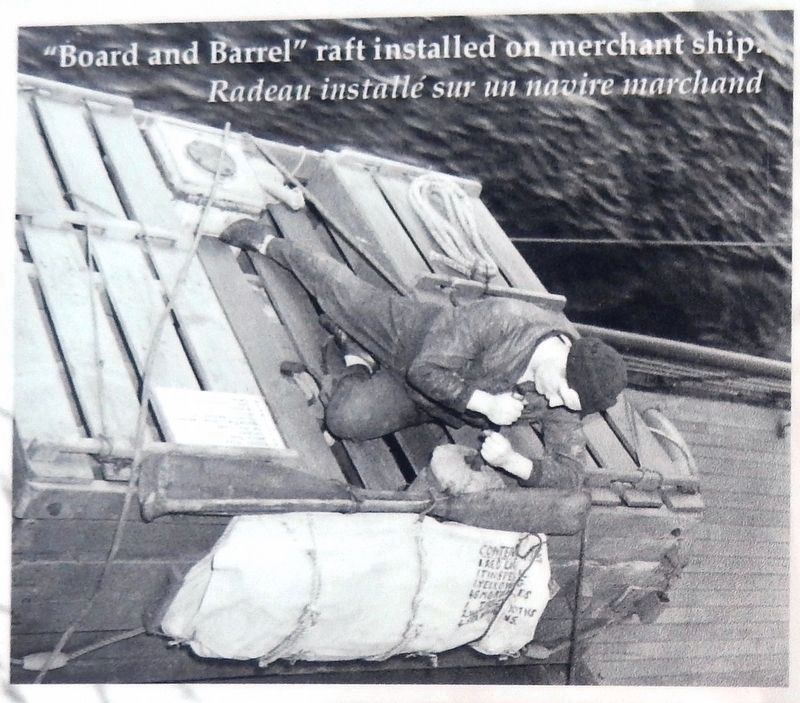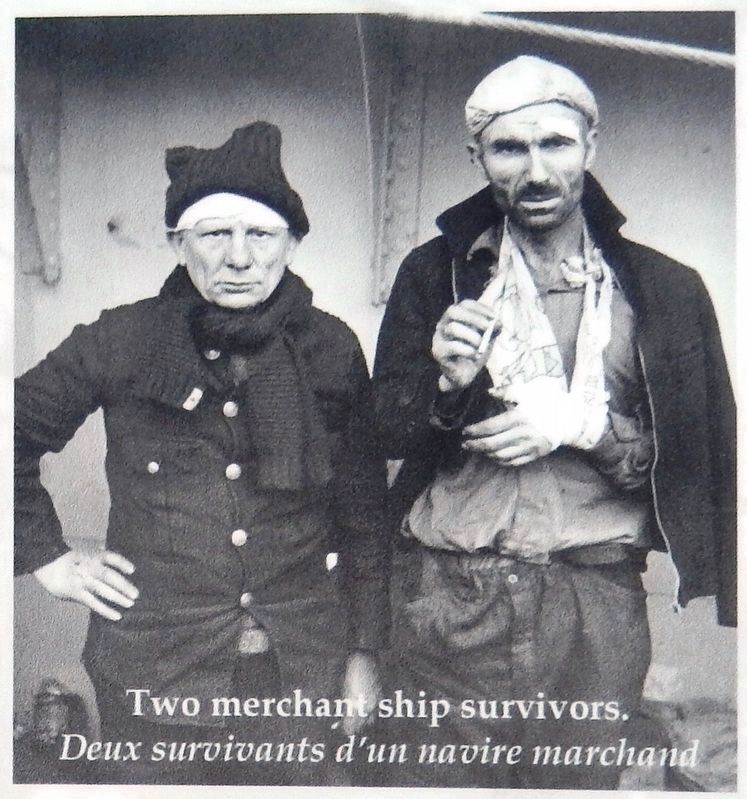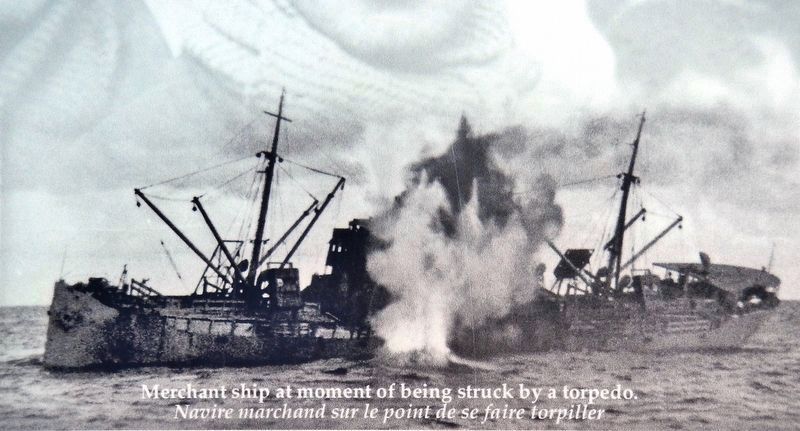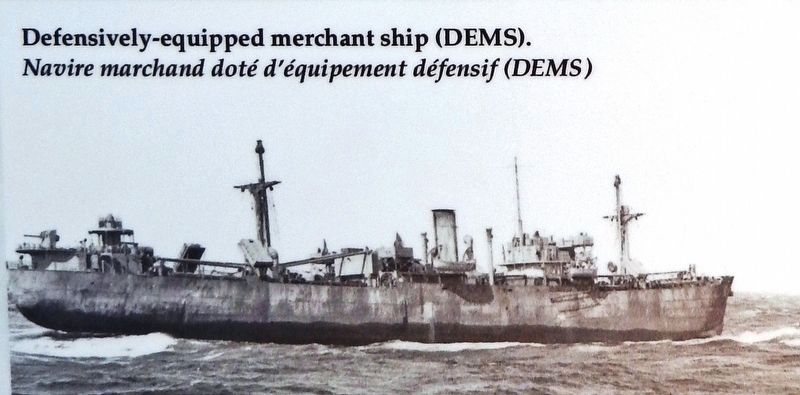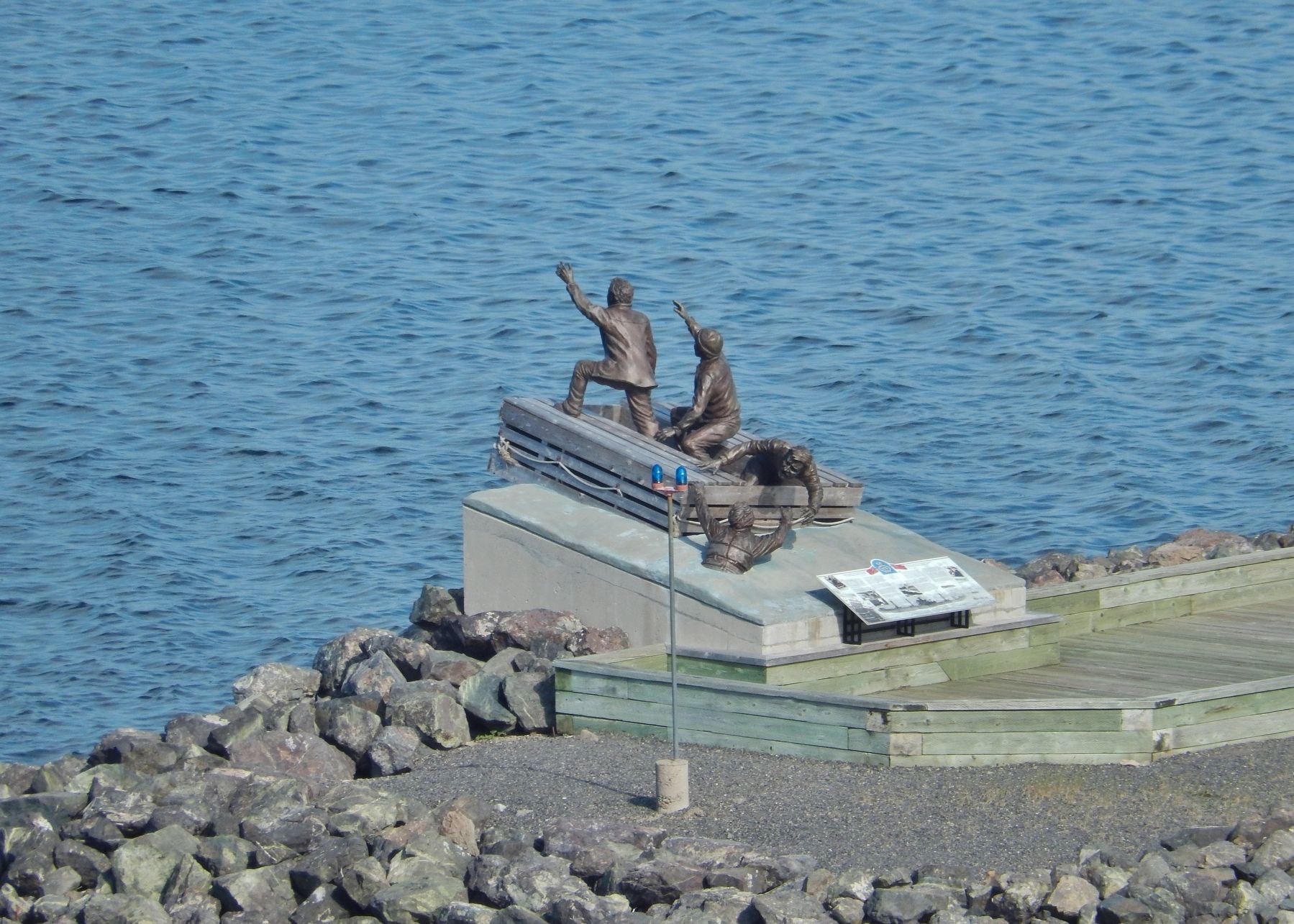Sydney in Cape Breton Region, Nova Scotia — The Atlantic Provinces (North America)
Canadian Merchant Navy
World War II
"Voyage after voyage, men who had seen a dozen ships go down about them, men who had been torpedoed once, twice, three times, sailed and sailed again."
—Joseph Schull, Merchant Seaman
During the Second World War, coal, steel, and other important war materials shipped from Sydney were essential ingredients for the Allied war effort in Europe. Early in the war, Sydney became the assembly port for convoys, often described as the lifeline to Europe. The convoys from Sydney most often consisted of merchant ships that were never intended for the open sea. Often old and dilapidated, many considered as "tramps", these ships were hastily pressed into service. With the older ships, the convoys that sailed from Sydney tended to be slower than other convoys. Because of this, the prefix SC (for Slow Convoy) was used to identify each convoy from Sydney.
Because of the demand for manpower for the armed forces, and industry, it was not uncommon to see men in their forties and fifties serving together on merchant ships with teenaged boys, some as young as fourteen. A small number of women also joined the merchant navy and served throughout the war.
During the Battle of the Atlantic (1939-1945) the danger of a merchant ship being torpedoed or bombed remained constant. Often without warning there was an explosion, followed by the cries of merchant sailors struggling to survive in the cold, oil-slicked and often burning waters of the North Atlantic. Ships loaded with fuel or ammunition were particularly dangerous. If torpedoed, there was the flash, then nothing. It was said there were no rats on a tanker, and that on every ship but a tanker, sailors wore a life preserver when they slept. On a tanker there was no point.
For those who survived, they faced hours, even days, on an open raft or in a small boat. Those left in the water did not survive long. A convoy could not stop to rescue survivors. For the fortunate few that were rescued, there were blankets, dry clothes, coffee, and rum. For thousands of others, there was only the eternal sea.
A total of 177 convoys sailed from Sydney during the Battle of the Atlantic, often averaging more than 14 ships per convoy. In one example alone, in October 1940, convoy SC-7 from Sydney lost 20 ships, totaling nearly 80,000 GRT (Gross Register Tonnage). During the Second World War, 48 Sydney convoys were successfully attacked by German U-Boats, resulting in the sinking of 226 ships for a total loss of 995,795 GRT.
While
larger ports such as New York and Halifax were well-known assembly points for convoys, the numbers demonstrate that Sydney played an equally significant and important role in securing victory in Europe.
[photo captions]
Fore view of a “Board and Barrel” raft on SS Narissa.
[background images]
• A group of merchant sailors after being rescued.
• Not all North Atlantic crossings were rough ones.
• ”We are as near to heaven as by sea as by land…”
A merchant ship wallows between waves in heavy seas. Storms were a constant threat to North American convoys.
« Voyage après voyage, les hommes qui avaient vu des dizaines de navires couler devant eux, qui s'étaient fait torpiller à maintes reprises, retournaient constamment en mer. »
—Joseph Schull, marin marchand
Pendant la Deuxième Guerre mondiale, le charbon, l'acier et d'autres matériaux expédiés de Sydney étaient essentiels à l'effort de guerre des Alliés en Europe. Dès le début, Sydney s'est fait le port de rassemblement de convois, le réseau vital de l'Europe. La plupart du temps, les convois de Sydney étaient formés de bateaux marchands qui n'étaient pas destinés aux eaux libres. Vieux et délabrés, ces navires étaient souvent préparés à la hâte pour la guerre. En raison de leur grand âge, les convois en partance
de Sydney avançaient plus lentement que les autres. Cela leur a valu le préfixe SC (signifiant « slow convoy » en anglais, ou convoi lent).
Compte tenu de la demande de main-d'œuvre des forces armées et de l'industrie, il arrivait souvent sur les bateaux marchands que des hommes dans la quarantaine et la cinquantaine côtoient des jeunes, certains ayant à peine 14 ans. Quelques femmes ont également fait partie de la marine marchande et ont servi pendant la guerre.
Pendant la bataille de l'Atlantique (1939-1945), les navires marchands étaient souvent la cible de torpillages ou de bombardements. Des explosions surgissaient sans mise en garde, faisant place aux cris des marins s'accrochant à la vie dans la marée noire frigide, souvent en feu, de l'Atlantique Nord. Les navires porteurs de combustible ou de munitions étaient dangereux. S'ils se faisaient torpiller, le ciel s'illuminait, puis plus rien. Les rats, apparemment, ne fréquentaient pas ces navires. Et pendant leur sommeil, les marins ne portaient pas de gilet de sauvetage, contrairement aux marins des autres navires, car ils ne servaient à rien.
Les naufragés en avaient pour des heures, voire des jours, à vaciller en mer. Ceux qui restaient dans l'eau n'en avaient pas pour longtemps à vivre. Les convois ne pouvaient leur porter secours. Les rescapés, quoique peu nombreux, avaient droit à des couvertures, des vêtements secs, du café et du rhum. La mer éternelle engouffrait les autres marins par milliers.
Pendant la bataille de l'Atlantique, 177 convois sont partis de Sydney. Chaque convoi comptait 14 navires en moyenne. En octobre 1940, 20 navires du convoi SC-7 en provenance de Sydney ont coulé, l'équivalent de près de 80 000 en tonnage brut enregistré. Pendant la Deuxième Guerre mondiale, les sous-marins allemands ont réussi à attaquer 48 convois de Sydney, d'où l'engloutissement de 226 navires et une perte de 995 795 en tonnage brut.
Même si les grands ports comme ceux de New York et d'Halifax étaient considérés comme d'importants points de rassemblement de convois, les faits prouvent que Sydney a joué un rôle tout aussi important dans la victoire de l'Europe.
[légende des photo]
Vue avant d'un radeau sur le navire à vapeur Narissa
[Image en arriére-plan]
• Groupe de marins marchands rescapés.
• Les traversées de l’Atlantique Nord n’étaient pas toutes pénibles.
• « Nous sommes aussi près du ciel en mer que sur terre... » Un navire marchand vacille entre les vagues de la mer houleuse. Les convois de l'Atlantique Nord subissaient la menace constante des tempêtes.
Topics and series. This historical marker is listed in these topic lists: Industry & Commerce • War, World II
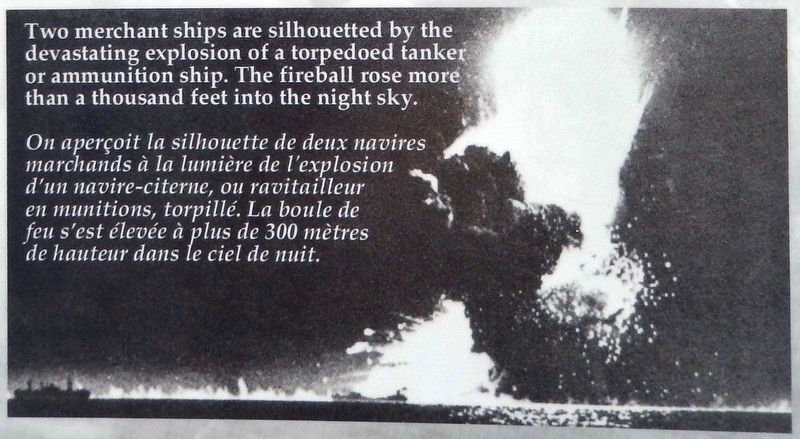
5. Marker detail: Explosion of a Torpedoed Tanker
• • •
On aperçoit la silhouette de deux navires marchands à la lumière de l'explosion d'un navire-citerne, ou ravitailleur en munitions, torpillé. La boule de feu s'est élevée à plus de 300 mètres de hauteur dans le ciel de nuit.
Location. 46° 8.373′ N, 60° 11.881′ W. Marker is in Sydney, Nova Scotia, in Cape Breton Region. Marker can be reached from the intersection of Esplanade and Dorchester Street, on the left when traveling north. Marker and monument are located on the Sydney Waterfront Boardwalk, at the Royal Cape Breton Yacht Club Marina. Touch for map. Marker is at or near this postal address: 246 Esplanade, Sydney NS B1P 6P4, Canada. Touch for directions.
Other nearby markers. At least 8 other markers are within walking distance of this marker. J.F.W. DesBarres (about 180 meters away, measured in a direct line); Sydney's Heritage Conservation District (about 180 meters away); Royal Bank Lion (approx. 0.3 kilometers away); St. George's Church (approx. 0.3 kilometers away); Joseph Frederick Wallet DesBarres (approx. 0.4 kilometers away); Sydney Harbour in the Second World War (approx. 0.4 kilometers away); Sir John George Bourinot (approx. 0.4 kilometers away); Cossit House (approx. 0.4 kilometers away). Touch for a list and map of all markers in Sydney.
Also see . . .
1. SC Convoys (Wikipedia). SC convoys ran from August 1940 until May 1945, although they were suspended
during the summer of 1944 when a number of escort groups were diverted to cover the Normandy landings. A total of 177 SC convoys ran during the campaign, totaling 6,806 ships. Only 3 failed to complete the passage: SC 52 suffered an attack shortly after leaving port, and was forced to return; and SC 62 and SC 63 were both scattered by appalling weather conditions which forced those ships to proceed independently. The SC convoys were the subject of some of the major battles of the campaign. (Submitted on April 21, 2021, by Cosmos Mariner of Cape Canaveral, Florida.)
2. The Battle of the Atlantic is Misnamed. Canada’s principle contribution to the Atlantic War was the provision of escort groups for the protection of merchant convoys to and from the United Kingdom. Canadian escorts also escorted convoys to other destinations, but the vast majority were of the ‘Slow Convoy’ or SC designation. (Submitted on April 21, 2021, by Cosmos Mariner of Cape Canaveral, Florida.)
Credits. This page was last revised on April 21, 2021. It was originally submitted on April 21, 2021, by Cosmos Mariner of Cape Canaveral, Florida. This page has been viewed 414 times since then and 48 times this year. Photos: 1, 2, 3, 4, 5, 6, 7, 8, 9, 10. submitted on April 21, 2021, by Cosmos Mariner of Cape Canaveral, Florida.
